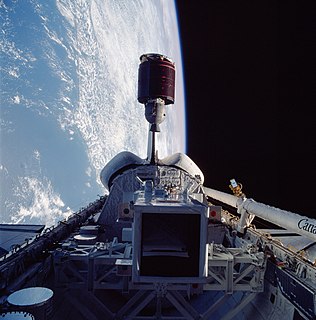Related Research Articles

STS-51-G was the 18th flight of NASA's Space Shuttle program, and the fifth flight of Space Shuttle Discovery. The seven-day mission launched from Kennedy Space Center, Florida, on June 17, 1985, and landed at Edwards Air Force Base, California, on June 24, 1985. Sultan bin Salman Al Saud from Saudi Arabia was on board as a payload specialist; Al Saud became the first Arab, the first Muslim, and the first member of a royal family to fly into space. It was also the first Space Shuttle mission which flew without at least one astronaut from the pre-Shuttle era among its crew.
Telstar 401 is a communications satellite owned by AT&T Corporation, which was launched in 1993, to replace Telstar 301. It was rendered inoperable by a magnetic storm in 1997.

Telesat, formerly Telesat Canada, is a Canadian satellite communications company founded on May 2, 1969. The company is headquartered in Ottawa.

VideoCipher is a brand name of analog scrambling and de-scrambling equipment for cable and satellite television invented primarily to enforce Television receive-only (TVRO) satellite equipment to only receive TV programming on a subscription basis.

SBS 4 was a geostationary communications satellite designed and manufactured by Hughes on the HS-376 platform. It was ordered by Satellite Business Systems, which later sold it to Hughes Communications. It had a Ku band payload and operated at 94°W longitude.
AlphaStar Digital Television was a direct-to-home satellite broadcasting service for the United States market developed by Canadian firm Tee-Comm Electronics. It was the first direct-to-home satellite broadcasting service in the United States to use the internationally accepted DVB-S broadcasting standard and used 39" satellite dish receivers. AlphaStar service launched in July 1996 but was discontinued completely by September 1997 with 40,000 subscribers as the company went through bankruptcy proceedings. The American assets of AlphaStar was used under the auspices of the Champion Telecom Platform which used to own the AlphaStar brand. AlphaStar would also have alleviated a shortage of Canadian satellite capacity by using foreign (US) satellite capacity to fill Canadian needs—indeed this was a requirement for the Canadian company to obtain its license from Canada to commence broadcasting. Tee-Comm, the parent company of AlphaStar had originally co-founded the partnership that created ExpressVu as technology supplier but later divested all interest in ExpressVu.

Satellite television is a service that delivers television programming to viewers by relaying it from a communications satellite orbiting the Earth directly to the viewer's location. The signals are received via an outdoor parabolic antenna commonly referred to as a satellite dish and a low-noise block downconverter.
Galaxy 26 is a communications satellite owned by Intelsat. It was built by Space Systems/Loral, as part of its SSL 1300 satellite bus. Galaxy 26 was formerly known as Intelsat Americas 6 and Telstar 6. It was launched aboard a Proton-K / DM-03 from Baikonur Cosmodrome, Site 81/23.
Galaxy 23 is the name given to the C-band service of the Galaxy 23/EchoStar 9 communications satellite jointly owned by Intelsat and EchoStar located at 121° W longitude, serving the North American market. It was built by Space Systems/Loral, as part of its FS-1300 line. Galaxy 23 was formerly known as Intelsat Americas 13. The "Galaxy 23" portion of the service provides transponders in the C band. The "EchoStar 9" portion broadcasts Ku band, and Ka band transponders.
TerreStar-1 is an American communications satellite which was operated by TerreStar Corporation. It was constructed by Space Systems/Loral, based on the LS-1300S bus, and carries E/F band transponders which will be used to provide mobile communications to North America. The signals are transmitted by an 18-metre (59 ft) reflector on the satellite. It had a launch mass of 6,910 kilograms (15,230 lb), making it the second most massive single satellite launched into a geosynchronous transfer orbit, and the second largest commercial communications satellite ever built. Its record as the most massive communication satellite was surpassed by Telstar 19V launched on Falcon 9 on July 21, 2018, with a mass of 7,076 kilograms (15,600 lb).

Telstar is the name of various communications satellites. The first two Telstar satellites were experimental and nearly identical. Telstar 1 launched on top of a Thor-Delta rocket on July 10, 1962. It successfully relayed through space the first television pictures, telephone calls, and telegraph images, and provided the first live transatlantic television feed. Telstar 2 launched May 7, 1963. Telstar 1 and 2—though no longer functional—still orbit the Earth.
Telstar 14R, also known as Estrela do Sul 2 is a commercial communications satellite in the Telstar series built by Space Systems/Loral for Telesat to provide Ku-band communications to South America and the Southern United States. It is a replacement for Telstar 14, whose north solar array failed to open after launch, limiting its mission effectiveness. Telstar 14R experienced the same problem, with its north solar array failing to open too, but is now in service despite that failure.
Telstar 14 or Estrela do Sul 1 is a commercial communications satellite in the Telstar series built by Space Systems/Loral (SS/L) for Telesat to provide Ku-band communications to South America and the Southern United States. Estrela do Sul 1 was launched by Sea Launch using a Zenit-3SL carrier rocket on 11 Jan 2004 for geosynchronous orbit at 63 degrees west.
EVOtv is a Croatian Pay TV provider founded and previously owned by Croatian Post, in 2018 purchased by T-HT. EVOtv offers Pay TV Digital Terrestrial Television based on DVB-T2 Technology. The service was introduced in December 2012 and currently carries 56 TV channels.
Yamal-401 is a Russian geostationary communications satellite operated by Gazprom Space Systems. It was built by ISS Reshetnev and is based on the Ekspress-2000 satellite bus. It is equipped with 17 C-band and 36 Ku-band transponders. It has a design life of 15 years.

Telstar 303 is a U.S. communications satellite launched from Space ShuttleDiscovery during STS-51-G on 17 June 1985. Owned by AT&T and operated by Loral Skynet Hughes Communications, it was one of three Telstar 3 satellites, Preceded by Telstar 301 in 1983 and Telstar 302 in 1984.
Yamal is a communication and broadcasting system developed and operated by Gazprom Space Systems. Born out of the connectivity needs of the natural gas extraction giant Gazprom, the system was spun off in its own company, and opened the network to third parties and even went into the public broadcasting industry. Yamal and Russian Satellite Communications Company (RSCC)'s Ekspress constellation are the only two national satellite operators in Russia.
Telstar 402 was a communications satellite owned by AT&T Corporation.
Telstar 4 was a communications satellite owned by AT&T Corporation.
EUTELSAT I F-2, also known as European Communications Satellite 2 (ECS-2) is a decommissioned communications satellite operated by the European Telecommunications Satellite Organisation (EUTELSAT). Launched in 1984, it was operated in geostationary orbit at a longitude of 7° East, before moving to several other locations later in its operational life, before it was finally decommissioned in 1993. It was the second of five satellites launched to form the first-generation Eutelsat constellation.
References
- ↑ McDowell, Jonathan. "Satellite Catalog". Jonathan's Space Page. Retrieved 24 October 2013.
- ↑ "Telstar 401, 402, 402R".